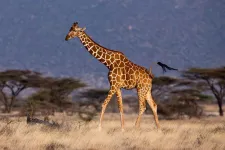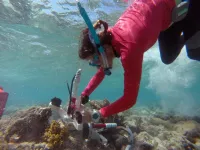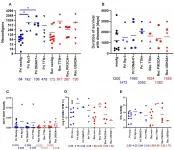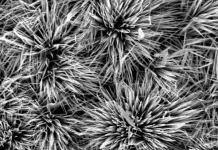INFORMATION:
Elephant seals vary time spent in light and darkness to optimize risk/reward trade-offs
Lightscapes of fear: How mesopredators balance starvation and predation in the open ocean
2021-03-17
(Press-News.org) While scientists have known that creatures may adjust the timing of their daily routines based on starvation and predation, these shifts have only previously been measured based on data from a population at a single point in time. Now, using data collected as 71 elephant seals undertook their foraging migrations across the North Pacific Ocean, researchers report a view of how these animals divide their time between light and darkness to optimize tradeoffs between risks and rewards based on 7 months of data per seal, collected between 2004 and 2012. Their findings refute a hypothesis about how seals prioritize feeding. To better understand how seals divide their time between light and darkness, Roxanne Beltran and colleagues used high-resolution biologgers to continuously measure elephant seals as they journeyed for 7 months across the North Pacific Ocean, monitoring shifts in their body fat, time spent in light and darkness, movement both across the ocean and to different depths, and exposure to risk. They observed that as the seals became plumper, they were more likely to engage in low-risk rest at night rather than high-reward hunting, refuting a hypothesis that feeding is always a higher priority than rest for these seals. Seals with more body fat also prioritized safety over energy conservation by resting where the water was considerably darker, more than 100 meters deeper than leaner seals. Additionally, for each hour increase in daylight time, the seals moved their bedtime earlier by about 11% of the day length. This suggests that predation risk in the daylight, rather than circadian rhythm or the timing of the seals' meals, determines their preferred resting time. The authors note that such findings, which illuminate the daily routines of elephant seals and other marine mammals, may help inform future conservation efforts. "As humans continue to threaten the ability of wild animals to forage efficiently and sleep safely, we must work to understand how physiology and ecology interact to shape the timing of fundamental behaviors," Beltran et al. write.
ELSE PRESS RELEASES FROM THIS DATE:
The trouble of being tall
2021-03-17
The giraffe is a truly puzzling animal. With its exceptional anatomy and suite of evolutionary adaptations, the giraffe is an outstanding case of animal evolution and physiology. Now, an international team of researchers from the University of Copenhagen and Northwestern Polytechnical University in China have produced a high-quality genome from the giraffe and investigated which genes are likely to be responsible for its unique biological features.
The extraordinary stature of the giraffe has led to a long list of physiological co-adaptations. The blood pressure of the giraffe, for instance, is twice as high as in humans and ...
Algae growing on dead coral could paint a falsely rosy portrait of reef health
2021-03-17
Washington, DC-- Algae colonizing dead coral are upending scientists' ability to accurately assess the health of a coral reef community, according to new work from a team of marine science experts led by Carnegie's Manoela Romanó de Orte and Ken Caldeira. Their findings are published in Limnology and Oceanography.
Corals are marine invertebrates that build tiny exoskeletons, which accumulate to form giant coral reefs. Widely appreciated for their beauty, these reefs are havens for biodiversity and crucial for the economies of many coastal communities. But they are endangered by ocean warming, seawater ...
Mobility data used to respond to COVID-19 can leave out older and non-white people
2021-03-17
Information on individuals' mobility--where they go as measured by their smartphones--has been used widely in devising and evaluating ways to respond to COVID-19, including how to target public health resources. Yet little attention has been paid to how reliable these data are and what sorts of demographic bias they possess. A new study tested the reliability and bias of widely used mobility data, finding that older and non-White voters are less likely to be captured by these data. Allocating public health resources based on such information could cause disproportionate harms to high-risk elderly and minority groups.
The study, by researchers at Carnegie Mellon University (CMU) and Stanford University, appears in the Proceedings of the ...
Oncotarget: Genomic and neoantigen evolution in head and neck squamous cell carcinoma
2021-03-17
Oncotarget published "Genomic and neoantigen evolution from primary tumor to first metastases in head and neck squamous cell carcinoma" which reported that prior work has characterized changes in the mutation burden between primary and recurrent tumors; however, little work has characterized the changes in neoantigen evolution.
These authors characterized genomic and neoantigen changes between 23 paired primary and recurrent head and neck squamous cell carcinoma (HNSCC) tumors.
Within these tumors, they identified 6 genes which have predicted neoantigens in 4 or more patients.
Within HNSCC tumors examined in this Oncotarget ...
Inexpensive tin packs a big punch for the future of supercapacitors
2021-03-17
A sustainable, powerful micro-supercapacitor may be on the horizon, thanks to an international collaboration of researchers from Penn State and the University of Electronic Science and Technology of China. Until now, the high-capacity, fast-charging energy storage devices have been limited by the composition of their electrodes -- the connections responsible for managing the flow of electrons during charging and dispensing energy. Now, researchers have developed a better material to improve connectivity while maintaining recyclability and low cost. ...
A deep dive into cells' RNA reality
2021-03-17
(BOSTON) ¬-- Human cells typically transcribe half of their roughly 20,000 genes into RNA molecules at any given time. Just like with proteins, the function of those RNA species not only relies on their abundance but also their precise localization within the 3D space of each cell. Many RNA molecules convey gene information from the cell's nucleus to the protein-synthesizing machinery distributed throughout the cytoplasm (messenger RNAs or mRNAs), others are components of that machinery itself, while still different ones regulate genes and their expression, or have functions that remain to be discovered. Importantly, many diseases including cancer and neurological diseases have signatures that appear as changes in the abundance and distribution of RNAs.
To enable the analysis ...
The a7 protein is ready for its close-up
2021-03-17
DALLAS - March 17, 2021 - UT Southwestern researchers have identified the structure of a key member of a family of proteins called nicotinic acetylcholine receptors in three different shapes. The work, published online today in Cell, could eventually lead to new pharmaceutical treatments for a large range of diseases or infections including schizophrenia, lung cancer, and even COVID-19.
Nicotinic acetylcholine receptors are members of a broader super-family of proteins called Cys-loop receptors that function as ion channels on cell surfaces and are found in the membranes of many cell types. When the right molecule settles ...
Three times the gains
2021-03-17
From climate change and carbon emissions to biodiversity and global hunger, humanity faces so many challenges that tackling them quickly is a daunting task. One solution that potentially addresses multiple issues could provide the impetus society needs to make significant progress.
An international team of 26 authors, including six at UC Santa Barbara, has just published a study in the prestigious journal Nature offering a combined solution to several of humanity's most pressing challenges. It is the most comprehensive assessment to date of where strict ocean protection can contribute ...
Suicide risk prediction models could be cost-effective in clinical practice
2021-03-17
BOSTON - There are several effective interventions to reduce the risk of suicide, the tenth-leading cause of death in the United States, but difficulties in identifying people at risk for suicide and concerns about the potentially high costs of suicide-prevention strategies have hampered their wider use.
But as researchers at Massachusetts General Hospital (MGH) demonstrate, statistical suicide risk prevention models could be implemented cost-effectively in U.S. health care systems and might help save many lives each year.
By evaluating data on the incidence of suicide and suicide attempts, the costs to society and the health care system of suicide, and the cost and effectiveness of suicide risk-reduction interventions, Eric ...
Global warming helps invasive species flourish - study models likely combined effects on ecosystems
2021-03-17
Increased global temperatures help invasive species establish themselves in ecosystems, new research led by a Swansea University bioscientist has shown.
The study, published by the Royal Society, gives an insight into the probable combined effects of species invasions, which are becoming more common, and global warming.
Climate warming and biological invasions result in the loss of species. They also alter the structure of ecosystems and the ways in which species interact.
While there is already extensive research on how climate change and invasions affect ...
LAST 30 PRESS RELEASES:
Study: Teens use cellphones for an hour a day at school
After more than two years of war, Palestinian children are hungry, denied education and “like the living dead”
The untold story of life with Prader-Willi syndrome - according to the siblings who live it
How the parasite that ‘gave up sex’ found more hosts – and why its victory won’t last
When is it time to jump? The boiling frog problem of AI use in physics education
Twitter data reveals partisan divide in understanding why pollen season's getting worse
AI is quick but risky for updating old software
Revolutionizing biosecurity: new multi-omics framework to transform invasive species management
From ancient herb to modern medicine: new review unveils the multi-targeted healing potential of Borago officinalis
Building a global scientific community: Biological Diversity Journal announces dual recruitment of Editorial Board and Youth Editorial Board members
Microbes that break down antibiotics help protect ecosystems under drug pollution
Smart biochar that remembers pollutants offers a new way to clean water and recycle biomass
Rice genes matter more than domestication in shaping plant microbiomes
Ticking time bomb: Some farmers report as many as 70 tick encounters over a 6-month period
Turning garden and crop waste into plastics
Scientists discover ‘platypus galaxies’ in the early universe
Seeing thyroid cancer in a new light: when AI meets label-free imaging in the operating room
Neutrophil-to-lymphocyte ratio may aid risk stratification in depressive disorder
2026 Seismological Society of America Annual Meeting
AI-powered ECG analysis offers promising path for early detection of chronic obstructive pulmonary disease, says Mount Sinai researchers
GIMM uncovers flaws in lab-grown heart cells and paves the way for improved treatments
Cracking the evolutionary code of sleep
Medications could help the aging brain cope with surgery, memory impairment
Back pain linked to worse sleep years later in men over 65, according to study
CDC urges ‘shared decision-making’ on some childhood vaccines; many unclear about what that means
New research finds that an ‘equal treatment’ approach to economic opportunity advertising can backfire
Researchers create shape-shifting, self-navigating microparticles
Science army mobilizes to map US soil microbiome
Researchers develop new tools to turn grain crops into biosensors
Do supervised consumption sites bring increased crime? Study suggests that’s a myth
[Press-News.org] Elephant seals vary time spent in light and darkness to optimize risk/reward trade-offsLightscapes of fear: How mesopredators balance starvation and predation in the open ocean





